
The American robin is a migratory bird of the true thrush genus and Turdidae, the wider thrush family. It is named after the European robin because of its reddish-orange breast, though the two species are not closely related, with the European robin belonging to the Old World flycatcher family. The American robin is widely distributed throughout North America, wintering from southern Canada to central Mexico and along the Pacific coast.

The ring ouzel is a mainly European member of the thrush family Turdidae. It is a medium-sized thrush, 23–24 centimetres (9.1–9.4 in) in length and weighing 90–138 grams (3.2–4.9 oz). The male is predominantly black with a conspicuous white crescent across its breast. Females are browner and duller than males, and young birds may lack the pale chest markings altogether. In all but the northernmost part of its range, this is a high-altitude species, with three races breeding in mountains from Ireland east to Iran. It breeds in open mountain areas with some trees or shrubs, the latter often including heather, conifers, beech, hairy alpenrose or juniper. It is a migratory bird, leaving the breeding areas to winter in southern Europe, North Africa and Turkey, typically in mountains with juniper bushes. The typical clutch is 3–6 brown-flecked pale blue or greenish-blue eggs. They are incubated almost entirely by the female, with hatching normally occurring after 13 days. The altricial, downy chicks fledge in another 14 days and are dependent on their parents for about 12 days after fledging.

The mistle thrush, also spelled missel thrush, is a bird common to much of Europe, temperate Asia and North Africa. It is a year-round resident in a large part of its range, but northern and eastern populations migrate south for the winter, often in small flocks. It is a large thrush with pale grey-brown upper parts, a greyish-white chin and throat, and black spots on its pale yellow and off-white under parts. The sexes are similar in plumage, and its three subspecies show only minimal differences. The male has a loud, far-carrying song which is delivered even in wet and windy weather, earning the bird the old name of stormcock.

The African thrush or West African thrush is a passerine bird in the thrush family Turdidae. It is common in well-wooded areas over much of the western part of sub-Saharan Africa, it was once considered to be conspecific with the olive thrush but that species has now been split further. Populations are resident (non-migratory).

The fieldfare or the snowbird is a member of the thrush family Turdidae. It breeds in woodland and scrub in northern Europe and across the Palearctic. It is strongly migratory, with many northern birds moving south during the winter. It is a very rare breeder in Great Britain and Ireland, but winters in large numbers in the United Kingdom, Southern Europe, North Africa and the Middle East. It is omnivorous, eating a wide range of molluscs, insects and earthworms in the summer, and berries, grain and seeds in the winter.

The pied wheatear is a wheatear, a small insectivorous passerine bird that was formerly classed as a member of the thrush family Turdidae, but is now more generally considered to be an Old World flycatcher. This migratory central Asiatic wheatear occurs from the extreme southeast of Europe to China, and has been found wintering in India and northeastern Africa. It is a very rare vagrant to western Europe.

The dusky thrush is a member of the thrush family which breeds eastwards from central Siberia to Kamchatka wintering to Japan, South China and Myanmar. It is closely related to the more southerly breeding Naumann's thrush T. naumanni; the two have often been regarded as conspecific. The scientific name comes from Latin Turdus, "thrush" and Ancient Greek eunomos, "orderly".
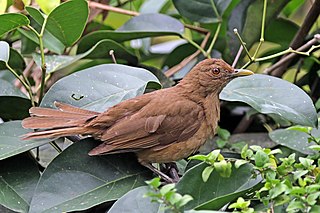
The clay-colored thrush is a common Middle American bird of the thrush family (Turdidae). It is the national bird of Costa Rica, where it is well known as the yigüirro. Other common names include clay-colored robin.
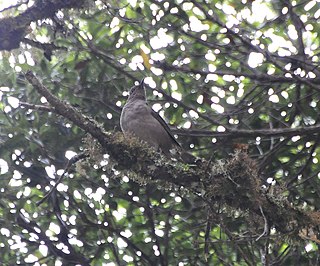
The mountain thrush is a large thrush which is found in Central America. It was formerly known as the mountain robin. Some authorities refer to it as the American mountain thrush to differentiate it from the Abyssinian thrush, known in their taxonomy as the African mountain thrush.

The forest thrush is a species of bird in the family Turdidae. It was historically the sole species within the genus Cichlherminia, however the AOU reclassified the species to the genus Turdus in 2009.

The creamy-bellied thrush is a species of bird in the family Turdidae. It occurs in a wide range of wooded habitats in a large part of central and eastern South America. It is generally common, even in human altered habitats such as gardens and parks. While the plumage varies from overall greyish to brownish, and the bill from dusky to yellow, adult creamy-breasted thrushes always have distinctive blackish lores. This separates it from other similar thrushes found in its range.

The Japanese thrush is a species of bird in the thrush family Turdidae. The species is also known as the grey thrush or the Japanese grey thrush. The species was once split into two subspecies, with birds breeding in China being treated as the subspecies T. c. lateus,, but today differences are attributed to natural variation and the species is treated as being monotypic.

The grey-sided thrush is a species of bird in the thrush family, Turdidae.
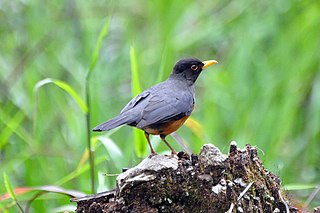
The chestnut-bellied thrush is a species of bird in the family Turdidae. It is found in Colombia, Ecuador, Peru, and Venezuela. Its natural habitats are subtropical or tropical moist montane forests and heavily degraded former forest.

The Kurrichane thrush is a species of bird in the thrush family Turdidae. The species is found from central through to southern Africa. Its natural habitat is dry savanna and woodland, predominantly miombo woodland.

The red-legged thrush is a species of bird in the family Turdidae. Native to the Caribbean, it is found in the Bahamas, Cayman Islands, Cuba, Dominica, Hispaniola and Puerto Rico. It formerly occurred on the Swan Islands, Honduras, but was extirpated there.
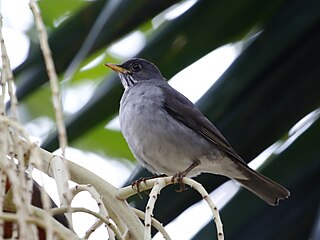
The blacksmith thrush or eastern slaty thrush is a passerine bird belonging to the genus Turdus in the thrush family, Turdidae. It is native to eastern South America. It was formerly considered conspecific with the Andean slaty thrush, with the combined species known as slaty thrush.

The Ecuadorian thrush is a resident bird found in western South America in western Ecuador and far northwestern Peru. It was formerly considered to be a subspecies of the spectacled thrush, Turdus nudigenis, but has a narrower eyering, and is widely separated in range.
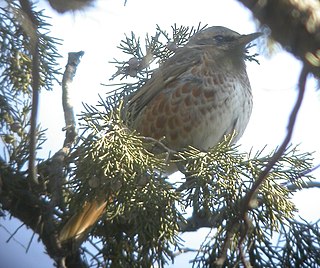
Naumann's thrush is a species of the thrush family Turdidae which breeds eastwards from central Siberia to North Manchuria, Amurland and Sakhalin. It is closely related to the more northerly breeding dusky thrush T. eunomus; the two have often been regarded as conspecific.






















